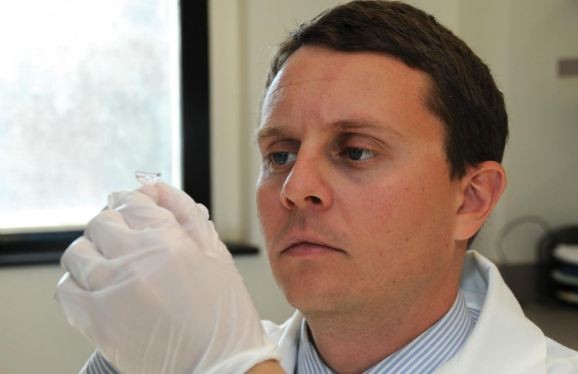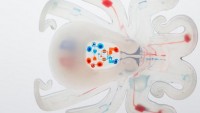Drug-dispensing Contact Lens Gradually Delivers Medication to Eyes of Glaucoma Patients
| Arthur Dominic Villasanta | | Aug 30, 2016 10:39 AM EDT |
(Photo : John Earle Photography) A contact lens designed to deliver medication gradually to the eye may improve outcomes for patients who struggle with imprecise, difficult to self-administer eye drops.
A contact lens that delivers medication gradually to the eye could improve outcomes for patients with conditions requiring treatment with eye drops, which are often imprecise and difficult to self-administer.
A team of researchers has shown that a novel contact lens-based system using a strategically placed drug polymer film to deliver medication gradually to the eye, is at least as effective (and possibly more so) as daily "latanoprost" eye drops in a pre-clinical model for glaucoma.
Like Us on Facebook
Glaucoma is the leading cause of irreversible blindness in the world. While there is no cure for glaucoma, ocular medications aim to lower pressure in the eye with the goal of preventing vision loss.
Researchers designed a novel contact lens that contains a thin film of drug-encapsulated polymers in the periphery. The drug-polymer film slows the drug's release into the lens.
Because the drug film is on the periphery, the center of the lens remains clear. This feature allows for normal visual acuity, breathability and hydration. Lenses can be made with no refractive power or with the ability to correct the refractive error in nearsighted or farsighted eyes.
"Instead of taking a contact lens and allowing it to absorb a drug and release it quickly, our lens uses a polymer film to house the drug, and the film has a large ratio of surface area to volume, allowing the drug to release more slowly," said senior author Daniel S. Kohane, M.D., Ph.D., director of the Laboratory for Biomaterials and Drug Delivery at Boston Children's Hospital.
Contact lenses have been studied as a means of ocular drug delivery for nearly 50 years. Many such lenses are ineffective because they dispense the drug too quickly, however.
Reserchers designed the contact lens to allow for a more controlled drug release. They had previously shown in a 2014 study the lens is capable of delivering medication continuously for one month.
"We found that a lower-dose contact lens delivered the same amount of pressure reduction as the latanoprost drops, and a higher-dose lens, interestingly enough, had better pressure reduction than the drops in our small study," said first author Joseph B. Ciolino, M.D., an ophthalmologist at Massachusetts Eye and Ear and an Assistant Professor of Ophthalmology at Harvard Medical School.
"Based on our preliminary data, the lenses have not only the potential to improve compliance for patients, but also the potential of providing better pressure reduction than the drops."
Currently, medications are delivered as eye drops, which sometimes cause stinging and burning, can be difficult to self-administer and are subsequently associated with poor patient compliance, with some studies suggesting that compliance is as low as 50 percent.
"This promising delivery system removes the burden of administration from the patient and ensures consistent delivery of medication to the eye, eliminating the ongoing concern of patient compliance with dosing," said Janet B. Serle, M.D., a glaucoma specialist at Icahn School of Medicine at Mount Sinai.
Tagscontact lens, drug polymer film, glaucoma, Daniel S. Kohane, Boston Children's Hospital
©2015 Chinatopix All rights reserved. Do not reproduce without permission
EDITOR'S PICKS
-

Did the Trump administration just announce plans for a trade war with ‘hostile’ China and Russia?
-

US Senate passes Taiwan travel bill slammed by China
-

As Yan Sihong’s family grieves, here are other Chinese students who went missing abroad. Some have never been found
-

Beijing blasts Western critics who ‘smear China’ with the term sharp power
-

China Envoy Seeks to Defuse Tensions With U.S. as a Trade War Brews
-

Singapore's Deputy PM Provides Bitcoin Vote of Confidence Amid China's Blanket Bans
-

China warns investors over risks in overseas virtual currency trading
-

Chinese government most trustworthy: survey
-

Kashima Antlers On Course For Back-To-Back Titles
MOST POPULAR
LATEST NEWS
Zhou Yongkang: China's Former Security Chief Sentenced to Life in Prison

China's former Chief of the Ministry of Public Security, Zhou Yongkang, has been given a life sentence after he was found guilty of abusing his office, bribery and deliberately ... Full Article
TRENDING STORY

China Pork Prices Expected to Stabilize As The Supplies Recover

Elephone P9000 Smartphone is now on Sale on Amazon India

There's a Big Chance Cliffhangers Won't Still Be Resolved When Grey's Anatomy Season 13 Returns

Supreme Court Ruled on Samsung vs Apple Dispute for Patent Infringement

Microsoft Surface Pro 5 Rumors and Release Date: What is the Latest?














